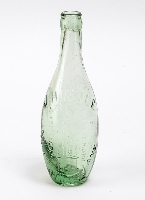Working Life
This section contains stories about the work that people used to do. Some relate to famous Hull companies that are still around today such as Reckitts. Others tell of less well-known craft firms and makers of the past. These include Richardson's furniture company and the goldsmiths of Church Lane. Many Hull soft drink and beer makers used bottles were made that feature Hull landmarks like the Wilberforce Monument. Shops were also important places of work for many.
 Reckitts of Hull
Reckitts of Hull
The Reckitts company name is nationally and internationally renowned for its quality of production in household cleaners and pharmaceuticals. A family run business, it has provided local employment for over 160 years, and is responsible for the manufacture of many famous household brands including Dettol, Harpic and Lemsip.
 Soft drinks - bottled by design
Soft drinks - bottled by design
Many shopkeepers were reluctant to store the drinks on their side to keep the cork wet, so manufacturers adopted a new shape devised by William Hamilton called the 'Hamilton Bowler'. This was egg-shaped with a rounded bottom preventing the bottle from standing upright. This shape came into general usage in 1840 and was used until the end of the nineteenth century.
 Medieval Decorated Floor Tiles
Medieval Decorated Floor Tiles
Before the thirteenth century, most tiled floors were mosaics. As they were costly and complicated to lay, floor tiles started to be made that had decoration on them. They were hand-made and fired in kilns that were often nearby the building they were made for. They featured animals, plant patterns, coats of arms and some even copied the geometric mosaics that they replaced. Discover them for yourself...
 Mr Walter Thomas Castelow
Mr Walter Thomas Castelow
Walter Thomas Castelow was born, 16th January, 1876 in Kirkgate, near Leeds. Castelow was locally educated at Middle Class School, Vernon Road, Leeds, before attending the Yorkshire College, now Leeds University. Working life began in 1894, when at the age of 16 he signed indentures as an apprentice for Messrs. Abbot and Anning, of Fenton Street, Leeds.
 159 Woodhouse Lane
159 Woodhouse Lane
Mr Walter Thomas Castelow's shop at 159 Woodhouse Lane was the oldest surviving chemist shop in Leeds when it was demolished for the redevelopment of the University in 1976.
 'Interior of a Wallpaper Manufacturers Workshop'
'Interior of a Wallpaper Manufacturers Workshop'
The painting depicts the interior of Hardy's wallpaper printing workshop at Junction Dock Street, Hull. It is thought to show work being carried out at the premises around 1840-45. It is of particular interest because it shows the three main stages involved in the production of printed wallpaper using woodblocks at this time.
 Romans Through the Looking Glass: Roman Glassware
Romans Through the Looking Glass: Roman Glassware
At the Hull and East Riding Museum, there is a collection of Roman glass that is not only beautiful to look at but has a fascinating story to tell about its use during the Roman Empire. This story explains a little about where and how the glass was made and who would have used it.
 Fizzy Pop and Water
Fizzy Pop and Water
During the nineteenth and early twentieth centuries, Hull had a prosperous soft drinks industry, with 23 makers listed in the 1892 Bulmer's 'Directory of Hull'. A wide range of drinks were made including lemonade, soda, ginger beer, orangeade and 'aerated water'.
 Hull's One and Only Glass Company
Hull's One and Only Glass Company
Enterprise flourished when a group of business men decided to open a glass factory in Hull. Follow the link and find out how they fared and what the small community in Wilmington may have been like.
 NHS Diamond Anniversary - Happy 60th birthday!
NHS Diamond Anniversary - Happy 60th birthday!
Free healthcare for all from the cradle to the grave. Read more about the launch of the National Health Service 60 years on.
 Making the medicines
Making the medicines
Whilst there were a number of medicines which were ordered from outside companies, most remedies were composed behind the chemist's counter. It was a time consuming and skilled process. Read on to discover the life of a pill, from mortar to medicine bottle.
 Danger in the Dispensary
Danger in the Dispensary
We visit a chemist shop assuming we will be given a safe and helpful remedy to cure our complaints. Today that is just what we receive but in the past there was a darker more dangerous side to the local pharmacy. Read on to discover a taste of the old medicine.
 The carboy
The carboy
Seen in many a chemist shop window, the carboy was an impressive symbol of the pharmaceutical profession. There was a range of designs and the coloured liquid contained inside made them an appealing addition to any window display. Read on to discover their origins and uses.






